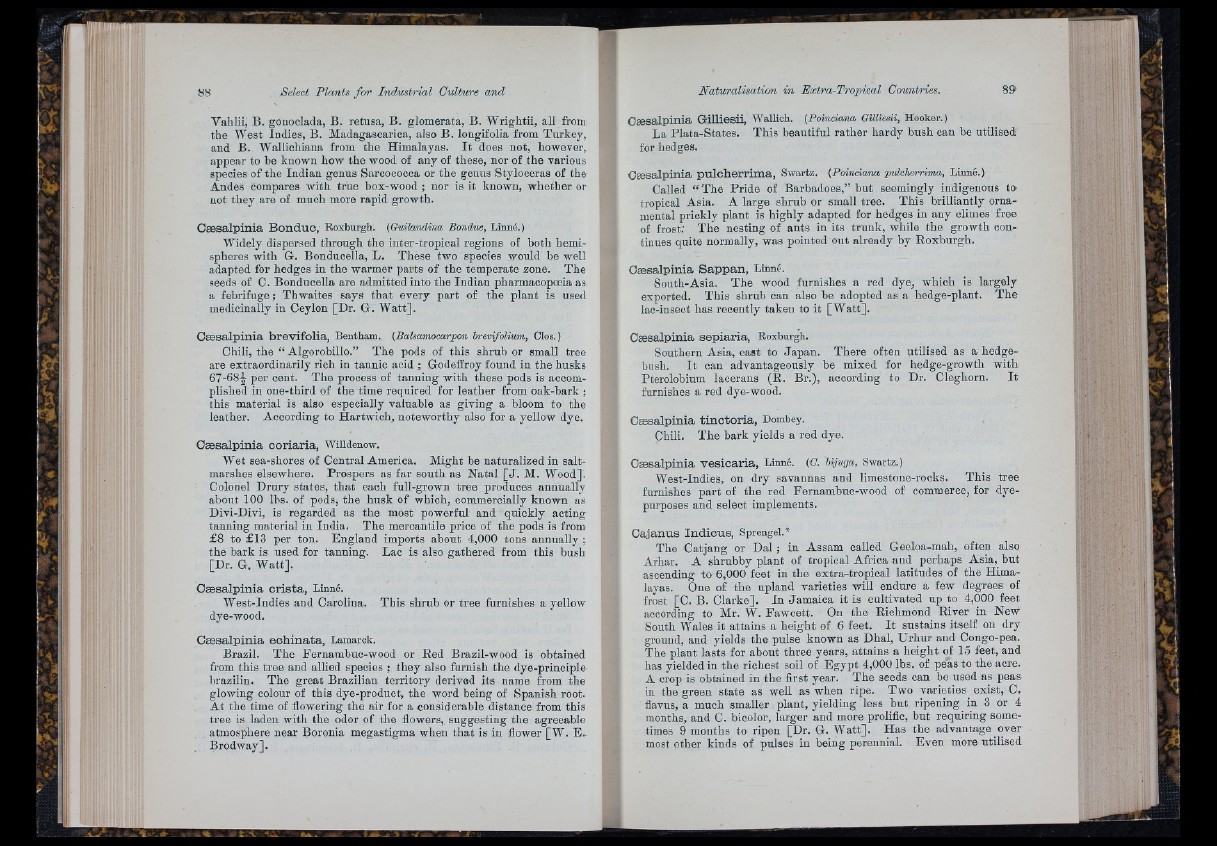
Vahlii, B. gouoolada, B. retusa, B. glomerata, B. Wrightii, all from
the West Indies, B. Madagasoarica, also B. longifolia from Turkey,
and B. Wallichiana from the Himalayas. I t does not, however,,
appear to be known how the wood of any of these, nor of the various
species of the Indian genus Sarcoeocea or the genus Styloceras of the
Andes compares with true box-wood ; nor is it known, whether or
not they are of much more rapid growth.
C æ s a lp in ia B o n d u c , Roxburgh. (Guilandina Bonduc, Linné.)
Widely dispersed through the inter-tropical regions of both hemispheres
with G. Bonduoella, L. These two species would be well
adapted for hedges in the warmer parts of the temperate zone. The
seeds of C. Bonducella are admitted into the Indian pharmacopoeia as
a febrifuge ; Thwaites says th a t every part of the plant is used
medicinally in Ceylon [Dr. G. Watt].
C s e s a lp in ia b r e v ifo lia , Bentham. (Balsamocarpon hrevifolium, Clos.)
Chili, the “ Algorobillo.” The pods of this shrub or small tree
are extraordinarily rich in tannic acid ; GodeSroy found in the husks
67-68^ per cent. The process of tanning with these pods is accomplished
in one-third of the time required for leather from oak-bark ;
this material is also especially valuable as giving a bloom to the
leather. According to Hartwioh, noteworthy also for a yellow dye.
C æ s a lp in ia c o r ia r ia , Willdenow.
Wet sea-shores of Central America. Might be naturalized in salt-
marshes elsewhere. Prospers as fa r south as Natal [ J . M. Wood].
Colonel Drury states, th a t each full-grown tree produces annually
about 100 lbs. of pods, the husk of which, commercially known as
Divi-Divi, is regarded as the most powerful and quickly acting
tanning material in India. The mercantile price of the pods is from
£8 to £13 per ton. England imports about 4,000 tons annually ;
the hark is used for tanning. Lac is also gathered from this bush
[Dr. G. Wa tt].
C æ s a lp in i a c r i s t a , Linné.
West-Indies and Carolina,
dye-wood.
This shrub or tree furnishes a yellow
C e e s a lp in ia e c h in a t a , Lamarck.
Brazil. The Fernambuc-wood or Red Brazil-wood is obtained
from this tree and allied species ; they also furnish the dye-priuciple
hrazilin. The great Brazilian territory derived its name from the
glowing colour of this dye-product, the word being of Spanish root.
A t the time of flowering the air for a considerable distance from this
tree is laden with the odor of the flowers, suggesting the agreeable
atmosphere near Boronia megastigma when th a t is in flower [W. E..
Brodway].
C æ s a lp in ia G illie s ii, Wallich. (Poinciana Gilliesii, Hooker.)
La Plata-States. This beautiful rather hardy bush can be utilised
for hedges.
C æ s a lp in ia p u l c h e r r im a , Swartz. (Poinciana puleherrima, Linné.)
Called “ The Pride of Barbadoes,” but seemingly indigenous tO'
tropical Asia. A large shrub or small tree. This brilliantly ornamental
prickly plant is highly adapted for hedges in any climes free
of frost; The nesting of ants in its trunk, while the growth continues
quite normally, was pointed out already by Roxburgh.
C æ s a lp in ia S a p p a n , Linné.
South-Asia. The wood furnishes a red dye, which is largely
exported. This shrub can also be adopted as a hedge-plant. The
lac-insect has recently taken to it [W a tt].
C æ s a lp in ia s e p ia r ia , Roxburgh.
Southern Asia, east to Japan. There often utilised as a hedge-
bush. I t can advantageously be mixed for hedge-growth with
Pterolobinm lacerans (R. Br.), according to Dr. Cleghorn. I t
furnishes a red dye-wood.
C æ s a lp in ia t in c t o r i a , Dombey.
Chili. The bark yields a red dye.
C æ s a lp in ia v e s io a r ia , Linné. (G. Ujuga, Swartz.)
West-Indies, on dry savannas and limestone-rocks. This tree
furnishes part of the red Fernamhue-wood of commerce, for dye-
purposes and select implements.
C a ja n u s I n d i e n s , Sprengel.*
The Catjang or Dal ; in Assam called Geeloa-mah, often also
Arhar. A shrubby plant of tropical Africa and perhaps Asia, but
ascending to 6,000 feet in the extra-tropical latitudes of the Himalayas.
One of the upland varieties will endure a few degrees of
frost [C. B. Clarke]. In Jamaica it is cultivated up to 4,000 feet
according to Mr. W. Fawcett. On the Richmond River in New
South Wales it attains a height of 6 feet. I t sustains itself on dry
ground, and yields the pulse known as Dhal, Urhur and Congo-pea.
The plant lasts for about three years, attains a height of 15 feet, and
has yielded in the richest soil of Egypt 4,000 lbs. of peas to the acre.
A crop is obtained in the first year. The seeds can be used as peas
in the green state as well as when ripe. Two v.arieties exist, C.
flavus, a much smaller plant, yielding less but ripening in 3 or 4
months, and C. bicolor, larger and more prolific, hut requiring sometimes
9 months to ripen [Dr. G. W a tt]. Has the advantage over
most other kinds of pulses in being perennial. Even more utilised